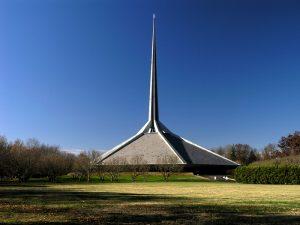
I want to share a few additional thoughts on Columbus, looking at the question of whether things really could have been different in the Rust Belt with different policies. I believe the answer is Yes, with caveats.
First, it’s undeniable, as I’ve written many times before, that macroeconomic change drove much of the Rust Belt collapse. Rust Belt challenges spanned many different states, red vs. blue political environments, etc. It’s also true that the Columbus model may not have been applicable or worked in the same way elsewhere, particularly in branch plant dominated cities.
However, the way things played out was not inevitable and I believe could have indeed been moderated. I’ll briefly discuss two items: labor relations and a comparison.
I think to a great extend Miller’s biggest accomplishment locally may have been avoiding the toxic labor relations that bedeviled much of the Rust Belt, something overlooked in the focus on architecture. Possibly this was in part because his company bloomed later than some other industries that saw massive strife in the prewar era. Nevertheless, Columbus and Cummins were examples of how to build a better management-labor union relations model.
Keep in mind, one of the factors affecting the Rust Belt was a relocation of factories to the Sunbelt to escape unions. People who aren’t old enough to remember the strikes of the 70s or before – my hometown of Louisville was known as “Strike City” – and know only an era when unions have been drastically reduced in influence perhaps have difficulty relating to this. Even today, the South continues to be a preferred domestic location for factory expansions. Columbus is something of a Sunbelt extension in this regard.
We see this particularly with foreign direct investment. While Cummins is clearly the 800lb gorilla in Columbus, the city has attracted a large number of foreign manufacturers, particularly from Japan. According to the city’s economic development organization, there are 24 Japanese enterprises in the city, along with others from Germany, France, Canada, China, Switzerland, and Saudi Arabia. A document I saw from a few years listing all Japanese businesses in the state of Indiana had Columbus second in the state after only much larger Indianapolis.
I do believe that had the Rust Belt had a better labor-management model, it would have remained much more competitive economically.
Secondly, although Cummins’ continued success (in contrast with say Studebaker in South Bend) is clearly critical for Columbus, I think it’s interesting to contrast Columbus with Peoria, home to the massively successful global firm Caterpillar. Cat also manufactures diesel engines and much, much more. I believe Cat employs about 15,000 people in Peoria and until very recently had its HQ there. It’s about 2x the size of Cummins in sales I believe. Cat has also faced bruising labor battles with the UAW over the years. Peoria is also home to Bradley University. Columbus doesn’t have a college, only a couple satellite programs.
Peoria certainly is not among the rustiest of Rust Belt cities. I’ve visited it and consider it a fine city. But is experiencing a number of challenges. It’s bigger than Columbus to be sure, so not an exact comparison, but it’s hardly a gigantic city either. Clearly Peoria and Columbus have been on different tracks.
If there had been clones of J. Irwin Miller in every city or running every major industrial concern, perhaps not all of them would have been saved, but I suspect many of them might have ended up in a much better place than they did.
This piece first appeared on aaronrenn.com.
Aaron M. Renn is an opinion-leading urban analyst, consultant, speaker, and writer on a mission to help America’s cities and people thrive and find real success in the 21st century.
North Christian Church, Columbus, Indiana. Photo Credit: Greg Hume, CC BY-SA 2.5












